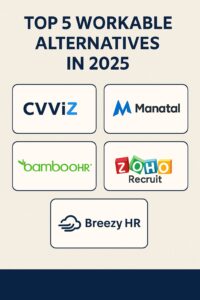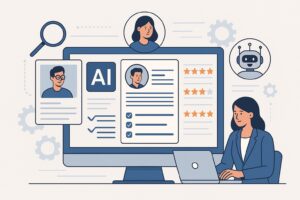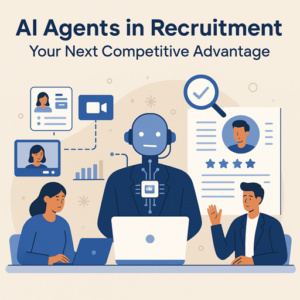An Applicant Tracking System (ATS) is supposed to make hiring and your life easier.
That’s the whole point, right?
But if you ask the exhausted recruiter staring at a spreadsheet that looks like an ancient artifact—or the HR manager drowning in mismatched candidate records—they might disagree.
Because here’s the thing: an ATS on its own is like a brilliant but absent-minded professor. It holds a wealth of knowledge but forgets to tell anyone where to find it. It sorts resumes, tracks applications, and manages interviews, but when you try to connect it with payroll, onboarding, or background checks, it suddenly behaves like an old printer—mysterious, temperamental, and determined to test your patience.
And so, companies end up doing what humans have done for centuries when faced with stubborn technology: they find workarounds. They manually copy data from one system to another and create endless email chains. And when that’s not enough they even print things out. (Seriously, why are we still printing things out?)
But it doesn’t have to be this way. ATS integration is the bridge between frustration and efficiency, the secret ingredient that transforms a disconnected mess of HR tools into a well-oiled machine. And if you do it right, you might just reclaim your sanity—and maybe even your lunch break.
In this guide, we’ll walk you through how to seamlessly integrate your ATS with HR software and other essential tools—without the headaches, the endless manual work, or the existential crisis over why your system refuses to sync.
Let’s get started.
Understanding ATS Integration
Somewhere in an office, a recruiter stares at their screen. Their applicant tracking system (ATS) is open—along with an Excel sheet, an email thread, and software they barely recognize. They copy a candidate’s details from the ATS and HR software, paste them into payroll, and then enter them again into the onboarding system. With a sigh, they wonder if hiring was always this complicated.
This is where ATS integration comes in.
It’s the difference between a system that just stores resumes and one that actually works for you. It connects your hiring software with other essential tools, so information flows seamlessly—without manual data entry, without duplicate records, and without recruiters considering a career change just to escape the chaos.
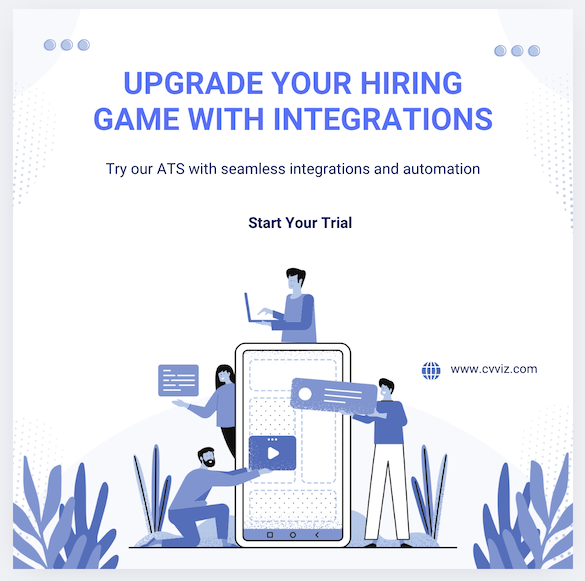
What Is ATS Integration?
Imagine your ATS and HR software as two old friends who refuse to talk to each other unless someone mediates. ATS integration is that mediator. It allows your applicant tracking system to connect with HR technology, payroll, onboarding tools, job boards, and more—so they share information in real time.
There are different ways this magic happens:
- Built-in integrations – Some hiring software comes with built-in integrations, offering pre-connected tools that seamlessly sync with essential platforms.
- ATS API – This is like a secret handshake that lets different systems exchange data.
- Third-party connectors – These are third-party tools that act as matchmakers between software that wouldn’t normally communicate.
No matter the method, the goal is the same: HR software integration should make life easier, not harder.
Why ATS Integration Matters
A well-integrated applicant tracking system isn’t just convenient—it’s game-changing. Here’s why:
- Recruitment automation: Instead of manually moving candidate data, everything updates instantly.
- No more duplicate work: Data flows seamlessly between your ATS and payroll, HR tools, and background check systems.
- Better candidate experience: Quick updates mean fewer delays in communication and hiring.
- Stronger compliance: Integrated systems ensure that records stay accurate and secure.
- Smarter hiring decisions: When your hiring software syncs with analytics tools, you get deeper insights into recruitment trends.
How to Know If You Need ATS Integration
If you’ve ever thought, “There has to be a better way,” you probably need ATS integration. But just in case, here are some telltale signs:
- You’re still copying and pasting candidate details between systems.
- Your ATS and HR software don’t “talk” to each other.
- Payroll errors keep happening because the information isn’t syncing.
- Reports take hours to compile because data is scattered across different tools.
- Your team spends more time managing systems than actually hiring people.
If any of this sounds familiar, it’s time to look at ATS best practices for integration—because, let’s be honest, no recruiter should have to juggle five different spreadsheets just to hire one person.
A well-connected applicant tracking system (ATS) doesn’t just save time—it transforms the entire hiring process. Without ATS integration, recruiters are stuck juggling multiple platforms, manually transferring data, and double-checking records for errors. With it, everything runs smoothly, and hiring becomes faster, smarter, and far less frustrating.
Key Benefits of ATS Integration
A well-connected applicant tracking system (ATS) doesn’t just save time—it transforms the entire hiring process. With it, everything runs smoothly, and hiring becomes faster, smarter, and far less frustrating.
Here’s how HR software integration can make a difference:
1. Time-Saving Recruitment Automation
With recruitment automation, your ATS and HR software sync in real-time, updating records instantly. This means fewer repetitive tasks and more time spent on what matters—finding the right talent.
2. Seamless Data Flow Between ATS and Payroll
Disconnected systems often lead to payroll errors, incorrect salaries, and unhappy employees. With proper ATS integration, new hire data flows effortlessly from the applicant tracking system to payroll, ensuring accurate compensation and compliance from day one.
3. Improved Candidate Experience
A slow, unorganized hiring process can frustrate job seekers. When hiring software integrates with communication tools, candidates receive timely updates, automated reminders, and a seamless onboarding experience.
The result? Better engagement and stronger employer branding.
4. Enhanced HR Technology Ecosystem
Think of HR technology as a puzzle—each tool needs to fit together perfectly. ATS integration connects your hiring software with job boards, background checks, onboarding platforms, and performance management tools, creating a unified system that works effortlessly.
5. Reduced Errors and Duplicate Work
Without HR software integration, recruiters waste hours fixing duplicate entries and correcting mistakes. An integrated applicant tracking system eliminates human errors by ensuring data consistency across all platforms.
6. Smarter Hiring Decisions with ATS Best Practices
A connected system means better insights. When your ATS and HR software integrate with analytics tools, you gain access to real-time hiring metrics, helping you refine recruitment strategies and make data-driven decisions.
Following ATS best practices ensures that your team hires faster and more effectively.
Steps to Sync Your ATS with HR Software and Other Tools
Integrating your applicant tracking system (ATS) with other platforms might sound complex, but with the right approach, it can be seamless. Whether you’re connecting your ATS and HR software, linking it to payroll, or automating tasks, following ATS best practices ensures smooth implementation.
Here’s a step-by-step guide to successful ATS integration:
1. Assess Your Current HR Technology Stack
Before diving into integration, take stock of your existing HR technology. Identify all tools used in your hiring process—hiring software, payroll, onboarding, job boards, and performance tracking systems. Understanding these connections will help you plan for a smoother HR software integration.
2. Define Integration Goals and Key Requirements
Ask yourself: What do you want to achieve with ATS integration?
- Do you need real-time data sharing between your ATS and payroll?
- Are you looking for recruitment automation to eliminate manual data entry?
- Should your hiring software sync with background check tools or compliance systems?
Defining clear objectives helps in selecting the right integration approach.
3. Choose the Right Integration Method
There are different ways to connect your applicant tracking system with other tools:
- Native Integrations – Many ATS and HR software solutions offer built-in connections.
- ATS API – An ATS API allows developers to create custom integrations tailored to your needs.
- Third-Party Connectors – Middleware tools act as bridges, enabling HR software integration without custom development.
The right choice depends on your tech stack, budget, and integration complexity.
4. Work with Your ATS Provider and IT Team
For a seamless ATS integration, collaborate with your ATS and HR software providers. They can guide you on available integrations, API capabilities, and necessary configurations. Your IT team can also help with ATS API implementation and troubleshooting.
5. Test the Integration for Accuracy and Efficiency
Before going live, test your applicant tracking system integration thoroughly:
- Ensure data flows correctly between your ATS and payroll systems.
- Check if recruitment automation functions as expected.
- Confirm that hiring reports and analytics pull accurate information.
Fix any inconsistencies before rolling it out to your entire team.
6. Train Your HR Team on ATS Best Practices
Even the best HR software integration is useless if no one knows how to use it. Provide hands-on training to recruiters, hiring managers, and HR teams so they understand how to navigate the integrated system efficiently.
7. Monitor Performance and Optimize Over Time
Once your ATS integration is in place, continuously track its performance. Monitor whether your hiring software is improving efficiency, reducing manual tasks, and providing better-hiring insights. Adjust configurations or upgrade integrations as needed to align with evolving business needs.
Common Challenges and How to Overcome Them
No ATS integration is without its hurdles. Somewhere in an HR department, a recruiter clicks “sync,” expecting a seamless connection between their applicant tracking system (ATS) and HR software. Instead, they get duplicate records, missing data, or—worst of all—a blank screen. They take a deep breath, sip their already cold coffee, and wonder why technology is never as simple as it promises to be.
Fortunately, most integration challenges have solutions. Here’s what could go wrong—and how to fix it.
1. Data Inconsistencies Between ATS and HR Software
One system says a candidate was hired, but another still lists them as “in process.” When ATS and HR software aren’t properly aligned, mismatched data can cause confusion.
🔹 How to Fix It: Standardize data entry formats across platforms. Ensure your ATS API is correctly configured to sync real-time updates and eliminate duplicate entries.
2. Limited ATS API Compatibility
Not all systems are built to communicate effortlessly. Some ATS API limitations prevent direct integration with certain payroll, onboarding, or compliance tools.
🔹 How to Fix It: Check for built-in integrations first. If none exist, explore third-party connectors or consult your IT team about a custom HR software integration using API workarounds.
3. Manual Work Despite Recruitment Automation
You implemented recruitment automation to reduce manual tasks—yet recruiters still find themselves entering candidate data by hand.
🔹 How to Fix It: Audit your integration setup to ensure automation is working as intended. If manual tasks persist, update workflows to fully leverage the potential of the Applicant Tracking System.
4. Security and Compliance Risks in HR Technology
Integrating multiple platforms means handling sensitive data. Weak HR technology connections can lead to security breaches or compliance violations.
🔹 How to Fix It: Work with IT to ensure encrypted data transfers, role-based access controls, and compliance with regulations like GDPR and SOC 2.
5. Resistance to Change Among HR Teams
Recruiters get used to their processes—even inefficient ones. A new ATS and payroll integration may seem like an unnecessary complication.
🔹 How to Fix It: Provide clear training on the benefits of HR software integration. Show how the system simplifies work rather than adding extra steps.
6. Poor Performance Due to Inadequate Testing
An integration that “kind of” works isn’t good enough. Without thorough testing, issues may surface later, disrupting hiring operations.
🔹 How to Fix It: Run multiple test scenarios before full deployment. Verify that your hiring software syncs correctly across job postings, candidate updates, and employee records.
7. Unexpected Costs and Budget Overruns
Sometimes, the cost of ATS integration extends beyond the initial setup—especially when additional tools or API customizations are required.
🔹 How to Fix It: Plan ahead by understanding integration costs, including licensing fees, development efforts, and potential third-party solutions.
Best Practices for a Successful ATS Integration
Somewhere in a hiring team’s Slack channel, a message pops up: “Is the ATS finally syncing with payroll?” A recruiter, who has spent days troubleshooting the HR software integration, hesitates before replying. They refresh the system—no errors. Candidate data, payroll details, and compliance reports are exactly where they should be. They exhale. Finally, it works.
A smooth ATS integration doesn’t happen by chance. It requires planning, testing, and following ATS best practices to ensure everything runs seamlessly. Here’s how to get it right:
1. Choose an ATS with Strong Integration Capabilities
Not all applicant tracking systems (ATS) are built for easy connectivity. Some have limited ATS API support, making it difficult to link with other HR technology tools.
✅ Best Practice: Before choosing an ATS, check its built-in integrations and ATS API capabilities. Look for a system that connects effortlessly with HR software, payroll, and other essential tools.
2. Prioritize Data Consistency Across HR Software
Recruiters shouldn’t have to wonder whether a candidate’s status in one system matches another. Inconsistent data between your ATS and HR software can cause errors, duplicate records, and hiring delays.
✅ Best Practice: Establish standard data formats and workflows across platforms. Ensure that all tools update candidate records in real-time.
3. Automate Wherever Possible with Recruitment Automation
If your team is still manually transferring data between systems, your ATS integration isn’t doing its job. Recruitment automation should eliminate repetitive tasks, not add to them.
✅ Best Practice: Set up automated workflows to sync applicant details, interview feedback, and onboarding information between your ATS and payroll, background checks, and compliance systems.
4. Conduct Thorough Testing Before Full Deployment
Even the best HR software integration can go wrong if not properly tested. Missing candidate profiles, payroll mismatches, or broken workflows can derail hiring efficiency.
✅ Best Practice: Run test scenarios before launching. Validate that data flows correctly between your hiring software and all integrated platforms.
5. Train Your Team on ATS Best Practices
A perfectly integrated applicant tracking system is only effective if your team knows how to use it. Confusion or resistance can lead to inefficiencies and workarounds that break the system.
✅ Best Practice: Provide hands-on training for recruiters, HR managers, and payroll teams. Ensure they understand how to leverage ATS and HR software to its full potential.
6. Keep Security and Compliance in Mind
With multiple systems sharing candidate and employee data, security is critical. Weak integrations can lead to data breaches or compliance violations.
✅ Best Practice: Work with IT to ensure encrypted data transfers, role-based access controls, and compliance with regulations like GDPR and SOC 2 when setting up your HR software integration.
7. Continuously Monitor and Optimize Integration Performance
Technology evolves, and so should your Applicant Tracking System. Systems may require updates, new integrations, or workflow adjustments over time.
✅ Best Practice: Regularly review your ATS and HR software performance. Identify any inefficiencies and optimize workflows to keep your hiring process running smoothly.
When done right, ATS integration doesn’t just simplify recruitment—it transforms it. With the right tools, automation, and ATS best practices, hiring teams can finally focus on what they do best: finding the right people.
Get the Right ATS Integration Partner, or Prepare for Chaos
Picture this:
A recruiter sitting at their desk, drowning in open tabs. Their applicant tracking system (ATS) is kind of connected to HR software, but they still manually copy-paste candidate details. The ATS API refuses to cooperate, payroll data is playing hide-and-seek, and somewhere in the chaos, a perfectly good hire gets lost in translation.
Now, imagine a different scenario.
Their ATS hums along smoothly, and recruitment automation is doing all the heavy lifting. Candidate info flows effortlessly between HR technology, hiring software, and payroll—no manual data entry, no errors, no lost sleep. They sip their coffee (still hot for once) and actually enjoy their job.
The difference? A good integration partner.
A well-executed ATS integration doesn’t just save time—it saves sanity. But getting it right requires expertise. If you’re still wrestling with disconnected HR software integration, it’s time to call in the pros.
The right company will:
- Align your ATS and HR software without breaking things
- Leverage ATS best practices to streamline workflows
- Ensure your ATS and payroll systems actually talk to each other
- Make recruitment automation work for you, not against you
- Handle the tech, so you can focus on hiring great talent
Because at the end of the day, HR teams should be hiring—not troubleshooting software. Get the right team on your side, and let your applicant tracking system work for you, not the other way around.
